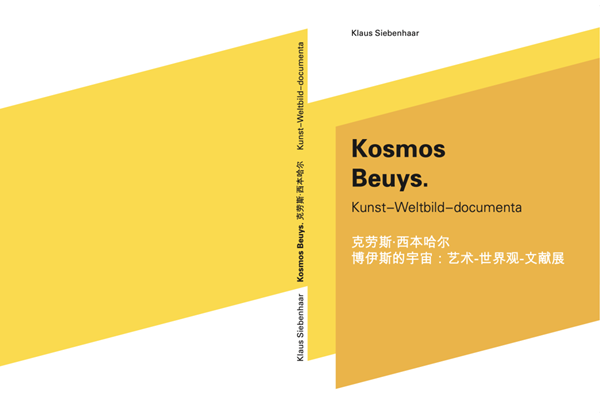
The Beuys Universe: Art - Worldview - documenta. Series VII
"The Social Sculpture":
Beuys’ Design of a New Society
The creative individual uses his inherent creativity in the "expanded concept of art" to create a new "social organism". This path to "social sculpture" (= direct democracy) is evolutionary. It is non-violent, and is bound to the transformative power of ideas, theories, words, programs,places of learning (= "offices", "schools", "universities"). Beuys' battle cry "The revolution is us" with himself as the advancing "prophet" expresses precisely this self-determined, actionist process of radical social change.
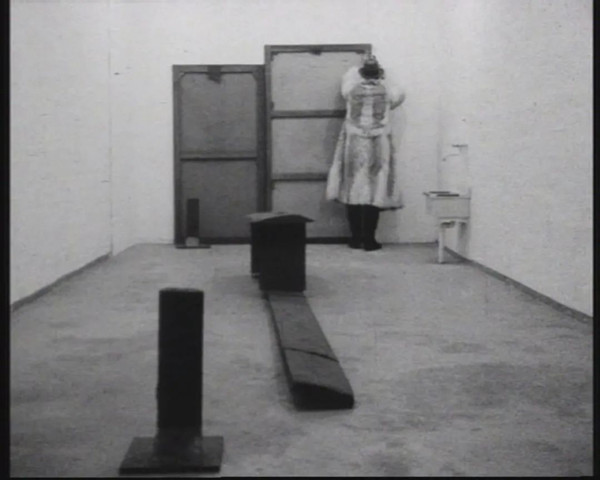
Trans-Siberian Railway, Joseph Beuys
blackand-white flim, 1970
Beuys' diverse, partly contradictory and short-lived political projects since the 1970s reflect his resolute orientation towards social change and the pressure to change. He articulated his goal at documenta 5 in the "Office of the Organisation for Direct Democracy through Referendum: " (...) we want to completely abolish the top-down form of government and only want the bottom-up form of government. Then you already come organically to central organs that do not have a centralistic effect." The "direct", consistently decentralised "rule of the people" is the "social sculpture" - that's what it all boils down to: politics becomes art.
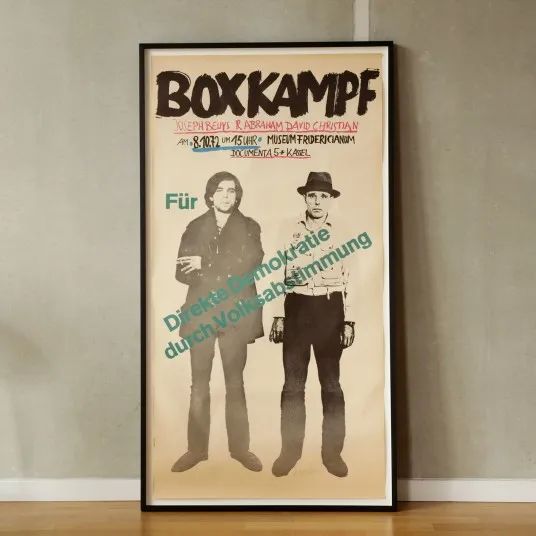
Boxkampf für direkte Demokratie
Joseph Beuys, 1972
First of all, Beuys saw his model of society as a counter-draft to capitalism, which he saw as based on destructive and speculative finance as well as the destruction of natural resources. The party state of representative democracy or party rule of communist provenance must also be overcome. The free, self-determined and creative individual shall take the place of collectivist concepts. All power shall emanate directly from the self-governing base, which replaces hierarchical "top-down" decisions. Beuys thus distanced himself decisively from both the Western-style parliamentary democracy system and the Soviet model of Eastern Europe.

Chinesischer Hasenzucker
Joseph Beuys,1972
Since the 1970s at the latest, his sympathies have been with the "Third Way", an alternative socialist system, as programmatically formulated in the "Prague Spring" of 1968 or in the "Charter 77". But he also believed he could recognize like-minded people and allies in the early phase of the grassroots democratic and radically ecological "Green Party", of which Beuys was one of the founding members. In very concrete terms, Beuys based his ideas of a "direct democracy by popular vote" on Rudolf Steiner's anthroposophical model of a "tripartite society" from the first decades of the 20th century.
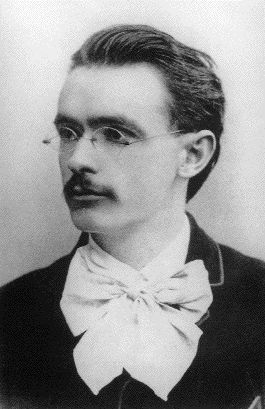
Rudolf Steiner,1888
Even before Steiner developed his concept under influence of the world war experience and the political collapse of the German Empire, he had already written a "Social Basic Law" inspired by European anarchism in 1905, in which he formulated the anthropological prerequisites, above all the overcoming of egoism and greed through a sense of community in solidarity: "The less an individual claims his work results for himself, the more benefits for the group of people working together. That is, the more of these results he gives away to his co-workers, the more his own needs are satisfied not from his achievements but from the achievements of others." In the spirit of the anarchist Max Stirner, Steiner sought to replace the "right of self-determination of people" with "the right of self-determination of the individual" in order to realise the idea of a "Third Way" beyond capitalism and nationalism, and later also against collectivist communism. From this starting point, Steiner developed his model of society, which was oriented towards the communal and cooperative ideas of the late 19th century and which also adapted the basic values of the French Revolution.
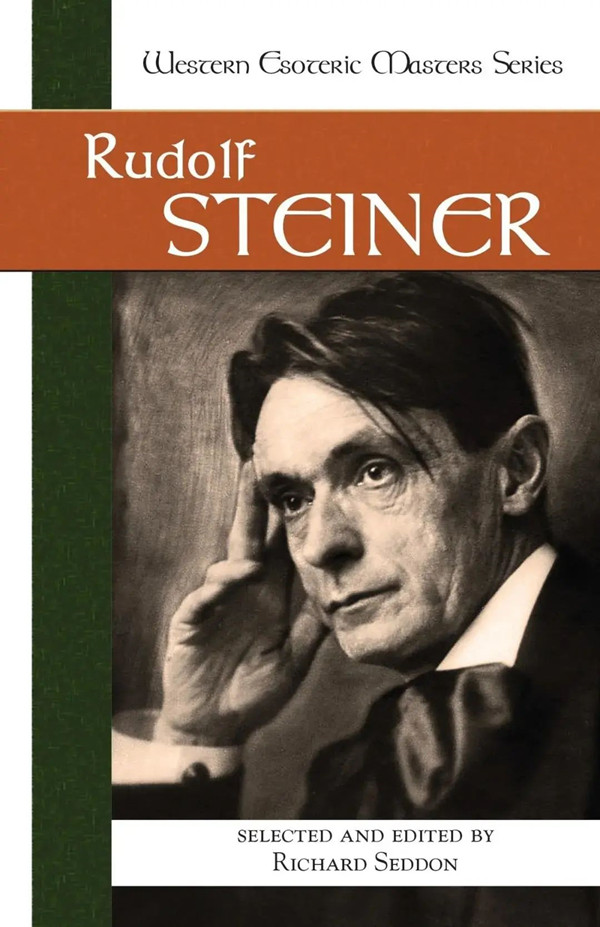
Die Philosophie der Freiheit,Rudolf Steiner,1894
Steiner's expanded ideas of a "tripartite society" are based on three equal "fields of force": the “cultural life", to which "freedom" is assigned, the “political life", which stands for "equality", and the "economic life", which is based on "brotherhood". These independent but communicating spheres are oriented towards the concepts of social anarchism (Proudhon, Kropotkin, Landauer) with its ideal of workers' self-administration, economic associations and communes. During his time in Berlin, the young Rudolf Steiner was immersed in the tension between anarchism and life reform in these political milieus and was influenced by them in a lasting way. This also included the theory of "free economy" as developed by Silvio Gesell after the First World War, in which grassroots democracy and socialism were to be realised in an exemplary way beyond the capitalist monetary and financial economy. Beuys drew on this pool of ideas and theories, and expanded and updated it with regard to the late 20th century.

Honey Pump at the Workplace
Joseph Beuys,1977
Democracy and socialism also formed the ideological coordinate system for Beuys, within which he determined the "social organism" or the "social sculpture" of cultural, political and economic life for his present and future in terms of content and system. Beuys did this through endless discussions, lectures, writings, but also graphically - and thus following his model Steiner - with numerous chalk diagrams on blackboards. His work on "social organism", with the help of the "expanded concept of art”, gained extensive influence at Documenta V with his "Office of the Organisation for Direct Democracy through Referendum" and at Documenta VI with his "Free International University" as well as the accompanying ‘Honeypump at the Workplace’ installation.
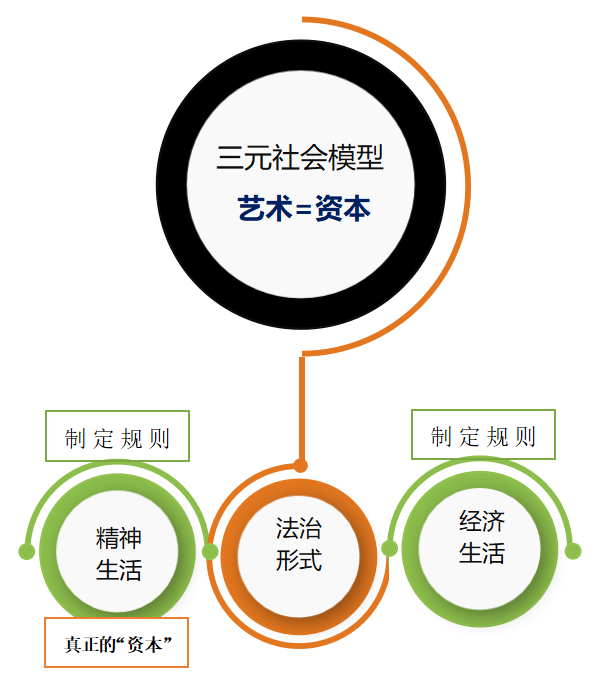
diagram of the Beuys ternary social model
The theoretical and conceptual framework, which was always decisive for Beuys' work, was thus the tripartite society model adopted from Steiner. Beuys interpreted and concretised it according to his own ideas. For Beuys, the "political form"(= “form” in Beuys' diction) in the middle was the "trunk of the whole organic structure"; with its constitution and canon of basic rights (co-)determined by all, it became the backbone of self-government. Furthermore, “political life" laid down the provisions for “cultural" and "economic life" in this tripartite "social organism". It is here, in "law", that the "power of self-determination of the human being" manifested itself. (Beuys). For Beuys, "cultural life" meant the cultural-spiritual "force field" of human "creativity”. It was the actual "capital", the assets of society: "Art = Capital".
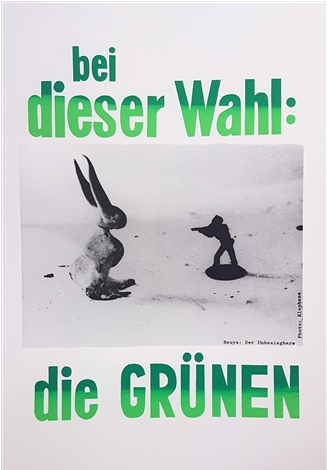
Vote Green in this Election, Joseph Beuys,1979
The spiritual, actional and physical creative power of every person, which is expressed in institutions of art, education, culture and science such as schools, academies, and universities, is the prerequisite of all social upheaval. The starting point and basic form for all action, especially in the field of economic life, is found in the spiritual sculpture. Beuys' economic theory, derived from Steiner, Gesell and above all from Wilhelm Schmundt from 1973 onwards, follows the principles of an inner circulatory system that leaves the "surplus value" generated in the system to finance "political" and "cultural life". In this way Beuys overcame the juxtaposition of Steiner’s tripartite model and at the same time gained - as Rainer Rappmann convincingly explained - in contemporary practicality.
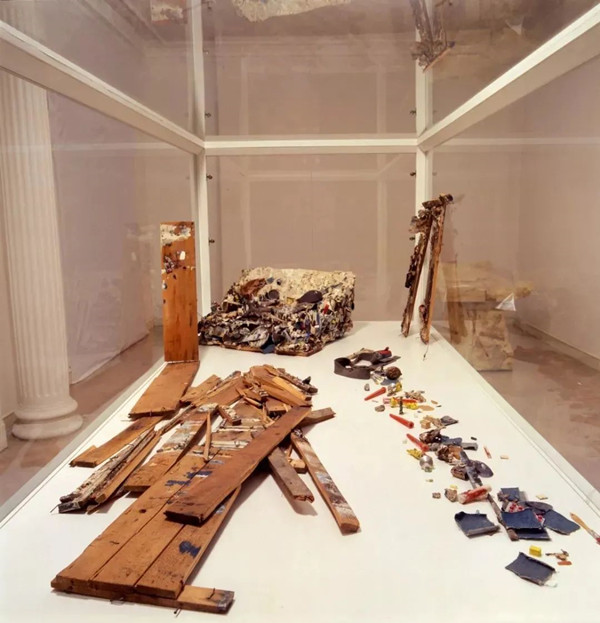
Hasengrab,Joseph Beuys,1964/1979
Yes, Schmundt's "Renewed Money System" became the economic equivalent of "expanded concept of art" for Beuys. Up until his death in 1986, Beuys repeatedly addressed the transformation of the "capital structure into art" in written and drawing forms on various blackboards, as Wilhelm Schmundt put it in clear reference to Beuys. Organic, comparable to blood circulation, and just as symbolized in his large-scale installation of 'Honeypump at the Workplace' at Documenta VI, Beuys imagined and developed an economic model that transformed individuals' "flow of skills" into "work" and "products", which would ultimately be available to fellow human beings.
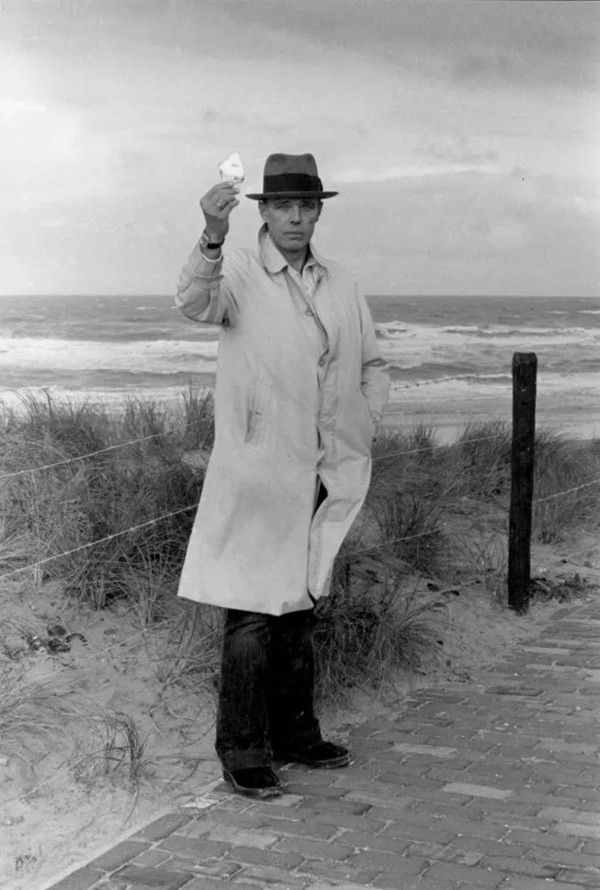
Beuys in Scheveningen, The Netherlands,1974
Photograph by Caroline Tisdall
In this economic circulation system, money "loses all reference to an economic value and flows back to the point of creation as money without a value relationship (through repayment/reversal of credits)" (Rainer Rappmann). This "change in the function of money", his new concept of "capital", called for by Beuys, was at the centre of his ultimately barter-economy (= free-economy) model: Since it circulates exclusively within the cycle as production and consumption capital, embedded in a cooperative credit system, the capitalist profit system takes care of itself for Beuys in an "organic" way.
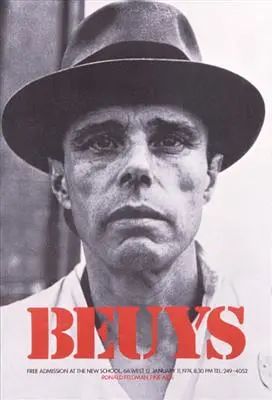
Joseph Beuys Poster
"Energy Plan for the Western Man", 1974
From the second half of the 1970s, Beuys became increasingly interested in concrete development plans for a new society, and he went far beyond Steiner's ideas. "Social sculpture" as a social fixed point of his "expanded concept of art" became more and more his dominant theme, urging practical realisation. But this in no way prevented Beuys from insisting on clarifying key concepts such as "freedom", "capital", "money", "social organism" or "direct democracy". For the "revolution of concepts" must precede the real social transformation, a credo to which Beuys steadfastly adhered. The "realisation of the alternative" was merely based on "thinking through to the end of historical approaches", otherwise it would be doomed to failure. "Whoever visualises this evolutionary alternative has a clear basic understanding of SOCIAL SCULPTURE on which MAN AS ARTIST shapes.
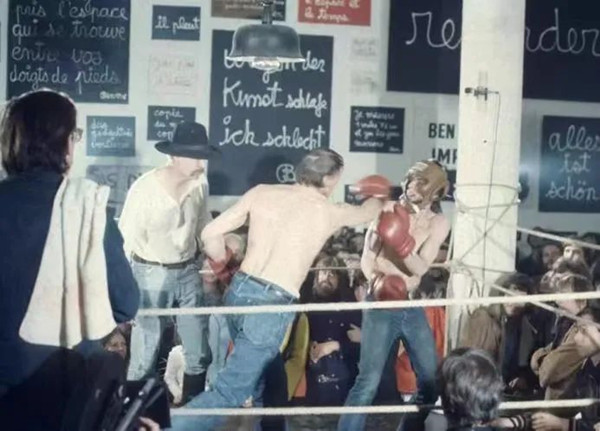
Boxkampf für direkte Demokratie
Joseph Beuys,1972
Whoever says that there must be a change, but skips the 'revolution of concepts' and runs only against the external embodiments of ideology, will fail. He will either resign, be content with reforms or end up in the cul-de-sac of terrorism". (Joseph Beuys) In practical terms, Beuys placed his hopes for a radical, peaceful transformation of society on alliances of autonomous groups whose ideological spectrum ranged from social Catholicism to libertarian Marxism - united in "ACTIVE TOLERANCE" as the "UNION FOR NEW DEMOCRACY", treading the "Third Way". Its revolutionary path is the non-violent act of will of the self-liberating individual.
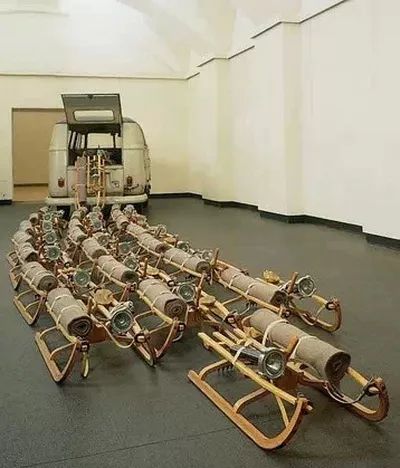
The Pack,Joseph Beuys,1969
The fact that this has remained a utopia to this day does not denounce the idea. Beuys' dream of a "form of government from the bottom up", his insistence on the "form of freedom" and an "evolution without coercion and arbitrariness" with art as a sculptural "productive force of society" contains a great human aspect: "becoming human" and "taking responsibility". The universal concept of design replaces the concept of politics and economics, and everything becomes art (= sculpture), including every form of work: "The concept of economics, work as the concept of art, specifically THE CAPITAL. (...) Profit, property and wage dependence as ideologies of the capitalist system will disappear."
